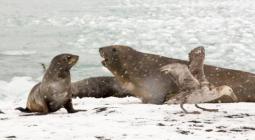‘Cautious optimism’ as penguins test positive for bird flu but show no symptoms
Asymptomatic cases may seem reassuring for the penguins, but scientists fear they could act as ‘Trojan horses’ for other species
Adélie penguins in Antarctica are testing positive for bird flu without showing outward signs of disease, according to researchers who travelled around 13 remote breeding sites on an ice-breaking cruise ship.
Since bird flu arrived in the region this year, there have been concerns about the virus reaching the Antarctic’s fragile penguin populations. In November last year, researchers warned in a pre-print research paper that if the virus caused mass mortality in these colonies, “it could signal one of the largest ecological disasters of modern times”.
In December 2023 and January 2024, scientists tested 16 Adélie penguins on Beagle island in the Antarctic peninsula for H5N1, and seven (43%) tested positive. Satellite trackers on the penguins showed they were alive and foraging as normal two months later in early March 2024. At another site on Red Rock Ridge, nine Adélie penguins were tested and one tested positive.
None showed any sign of disease, which is good news for the penguins – but researchers warn they could act as “Trojan horses” facilitating the spread of the virus to vulnerable species.
“These asymptomatic cases may seem reassuring for the species in question, but they have strong implications for Antarctic wildlife in general, potentially leading to unnoticed and widespread virus transmission,” wrote researchers, led by Fabiola León from UC Chile, in the bioRxiv paper, which has yet to be peer reviewed.
Their findings are cause for “some cautious optimism for penguin populations”, says Colin Butter, an associate professor of bioveterinary sciences at the University of Lincoln, who was not involved in the research.
While it is possible some penguin populations could be resistant, this cannot be known for certain, as many other penguin species have died in South America. Bird flu’s widespread distribution across Antarctica would also threaten other populations, including seals and whales. “The Antarctic ecosystem is precious and fragile. Influenza virus could cause devastating disruption from which it will not recover,” Butter said.
Ed Hutchinson, a molecular biologist from the MRC-University of Glasgow Centre for Virus Research, who was also not involved in the paper, said the limited sampling meant this survey only provided a snapshot of what was happening.
“The fact that apparently healthy birds were found to be infected with influenza viruses is really important, but it is not surprising,” he said. “We know from elsewhere in the world that some types of bird are more likely to become severely ill with this virus than others.
“As the spread of coronavirus in humans reminded us, the presence of healthy but infectious individuals can be a real problem in controlling the spread of an outbreak … this study highlights the importance of continued monitoring of this.”
Dr Connor Bamford, a virologist from Queen’s University Belfast said he was cautious about the findings. “More work is needed to study these animals with regard to avian influenza in sickness and in health. High mortalities associated with highly pathogenic H5 have been documented in penguins in the past … However, the reasons why these penguins appear to be protected, and its implications, are hard to say.”
The testing between December 2023 and January 2024 was conducted along the east and west coasts of the Antarctic peninsula and Antarctic western coast. It provides a snapshot of how the virus is spreading in the continent.
In total, 115 seemingly healthy birds were sampled, and nine tested positive, including eight Adélie penguins and one Antarctic shag. Researchers tested 31 emperor penguins and none tested positive. It is not possible to say if the virus had reached these colonies and was no longer present, or if these birds had not been exposed to it at all.
Bird flu was first confirmed on Antarctica’s mainland in February, after a number of cases in the sub-Antarctic islands. The paper’s researchers said: “The first-time detection of suspected cases of H5N1 influenza in penguins and cormorants in the Antarctic continent marks a significant expansion … into this isolated continent and puts highly vulnerable bird populations at risk.”
The spread of H5N1 has caused millions of wild birds to die globally, with thousands of sea lions and seals also dying from “spillover” events into wild mammals. After its arrival in the sub-Antarctic in October, there have been mortalities in about 10 species of Antarctic seabirds and seals.
Cover photo: H5N1 arrived on mainland Antarctica in February, and Adélie penguins have tested positive but without showing signs of disease. Photograph: Chris Johnson/PA







